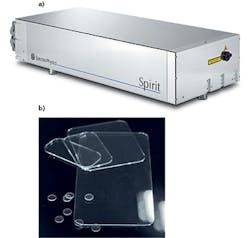Femtosecond laser processing of brittle materials
Laser processing of optically transparent or semi-transparent, brittle materials is finding wide use in various manufacturing sectors. For example, in consumer electronic devices such as smartphones, e-readers, and tablets, cover glass needs to be cut precisely in various shapes.
Processing of transparent brittle materials using ultrafast lasers provides advantages in comparison with long-pulse lasers. When an ultrafast laser is focused inside glass, only the localized region in the neighborhood of the focal volume absorbs laser energy by nonlinear optical absorption. Therefore, the processing volume is strongly defined locally, while the remainder of the target is unaffected. While ablative femtosecond processing provides the quality that industrial users demand, processing speed needs to be improved to achieve widespread economical industrial use. In this article, we describe a newly developed non-ablative femtosecond process, ClearShape, using the Spirit industrial femtosecond laser. The ClearShape process allows machining of curvilinear and internal closed-shape features in transparent, brittle materials such as chemically strengthened glass, unstrengthened glass, and sapphire with high quality and speed.
High cutting speed with unprecedented quality
Ultrafast lasers, with pulse duration in the femtosecond time scale, have proven their potential in many material processing applications. The unique advantages of ultrafast lasers, including high ablation efficiency and high accuracy of ablated structures on metal and dielectric targets, have been demonstrated in several studies [1-4]. Although the processing quality achieved meets industrial demands, processing speed needs to be improved to satisfy an economical industrial use [5, 6]. For example, our studies have shown that by using a commercially available industrial femtosecond laser system, the maximum cutting speed with an ablative process of 0.2mm/s is feasible for 0.5mm-thick chemically strengthened glass, which is not applicable in an industrial process [7]. Recently, Spectra-Physics developed a non-ablative femtosecond, patent-pending laser process called ClearShape to machine transparent and brittle material with cutting speed >1 m/s and very high quality.
Femtosecond lasers have been around for several decades. Until recently, though, they were complex, expensive, and required frequent tuning to sustain the demands of the production floor. The Spirit industrial femtosecond laser is a proven, highly reliable, and robust laser for micromachining and medical applications (FIGURE 1). This laser is widely deployed in demanding medical and manufacturing applications around the world.
To demonstrate the capability of the ClearShape femtosecond laser process, the Spirit laser has been applied to machine chemically strengthened Gorilla Glass (Corning). Glass with thickness of 0.55mm and depth of compression layer (DOL) of 20μm was used for the test. The cutting speed of up to 4 m/s was achieved using the ClearShape process in combination with this laser. A chipping size of <1 μm and average cut-edge roughness (Ra) of <0.1 μm was observed (FIGURE 2).In addition to chemically strengthened glass, the process can machine unstrengthened glass that is straight- or curvilinear-cut, and has internal closed-shape features. What's more, complex combinations of multilayer glasses can be processed. Additionally, this method has been applied to machining sapphire, which is highly scratch-resistant and, therefore, an appropriate material for smartphone camera windows or wristwatch covers. FIGURE 4 shows circular windows with a diameter of 6.4mm cut from 0.43mm-thick sapphire using this process. Sapphire windows can be machined with very high quality (minimum chipping) and high throughput (<0.5s/window).
Conclusions
The ClearShape patent-pending process has been developed to process optically transparent, brittle materials. The results presented in this article were obtained using the Spirit industrial femtosecond laser at the 1040nm wavelength, avoiding the need for more difficult-to-handle, higher-harmonic laser irradiations such as visible or UV laser light. Our results show that this robust and reliable femtosecond laser, in combination with the novel ClearShape process, results in an optimal solution for high-quality machining of a wide variety of transparent or semi-transparent, brittle materials at high process speeds demanded by industrial users.
ACKNOWLEDGEMENTS
ClearShape is a trademark of Spectra-Physics, while Spirit is a registered trademark of Spectra-Physics.
REFERENCES
1. C. Momma et al., Opt. Commun., 129, 134–142 (1996).
2. A. Ancona et al., Opt. Express, 16, 8958–8968 (2008).
3. B. N. Chichkov, C. Momma, S. Nolte, F. von Alvensleben, and A. Tünnermann, Appl. Phys. A, 63, 109–115 (1996).
4. C. Y. Chien and M. C. Gupta, Appl. Phys. A: Mater. Sci. Process., 81, 1257–1263 (2005).
5. F. Dausinger, F. Lichter, and H. Lubatschowski, Femtosecond Technology for Technical and Medical Applications, Springer, Heidelberg, Germany (2004).
6. J. König, S. Nolte, and A. Tünnermann, Opt. Express, 13, 10597–10607 (2005).
7. F. Hendricks, J. Aus der Au, and V. V. Matylitsky, Appl. Phys. A, 117, 149–153 (2014).
Victor Matylitsky | Senior Product Marketing Manager, MKS Spectra-Physics
Victor Matylitsky is Senior Product Marketing Manager at MKS Spectra-Physics (Rankweil, Austria).
Rajesh Patel | Independent Consultant
Rajesh Patel, now an independent consultant in laser applications, was with MKS Spectra-Physics from 2006 through 2018, with his most recent role there being Director of Strategic Marketing and Applications Engineering.
Frank Hendricks | Applications Engineer, MKS Spectra-Physics
Frank Hendricks was an Applications Engineer at MKS Spectra-Physics (Rankweil, Austria).



